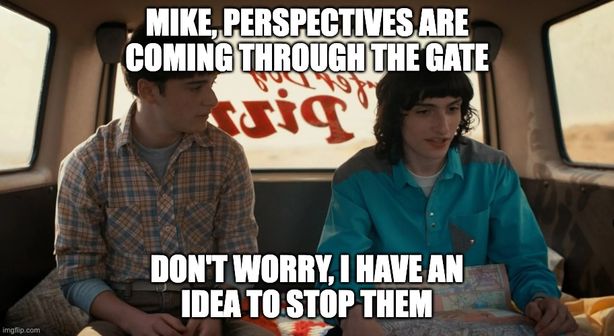What are perspectives in Studio? And why do I need to know about them?
- Subscribe to RSS Feed
- Mark as New
- Mark as Read
- Bookmark
- Subscribe
- Printer Friendly Page
- Report Inappropriate Content
I had recently come to an awakening. I’m connecting with you using various media everyday: blogging on the Community, responding to direct questions through customer success, listening to you on feedback calls, sharing our mid-term plans on InstructureCon and more. However, I realized that from time to time I talk about matters that are difficult to unfold in their entirety without referring to a concept that we call: perspectives.
When we have calls to discuss a feature, a new need or an existing issue, our goal is to explore the so-called problem space. Equivalently, the WHY of the matter. Perspectives haven’t been part of the problem space in the past, we avoided the word as much as possible. However, the product team works with it every day in the solution space, in the HOW of the matter.
I realized that I feel as if these two worlds have been starting to collide recently because there is this one little thing that wants to get from one world to the other.
No, no! Don’t stop them, Mike! Let’s handle them instead!
But how??
Let’s imagine you record yourself in Studio where you explain something important and then it is added to your Library. At that point, no course “knows” about that, your recording lives in your Studio Library and only you have access to it. You can share it with your colleagues within Studio to give them access, but it will still not be part of any Canvas course. Let’s get back to this later and now focus on the much more frequently used way of “sharing”: let’s embed it into a Canvas course (called Introduction to Philosophy), where you add it to a Canvas Page!
Congratulations, you have just created a perspective! Actually… this is the second perspective that you created in the last 45 seconds, but let’s now focus on the embedded media. The course defines an audience who has access to your recording. Students will generate viewership data (Insights) and can comment on the recording.
Now you have your recording in your Library that is only accessible to you (if not shared in Studio directly or via groups). This same recording is embedded to the Canvas Page that is accessible to the audience based on the Canvas course enrollments. If you comment on the one in your Library, then it won’t be displayed for students under the one in the Canvas Page. If students start to watch your embedded recording, viewership data will only be generated to the embedded one and will be different to the one in your Library.
To put it another way, Canvas displays the same media from different perspectives. If you embed the same media into a different Canvas course then another - third - perspective will be created. Which is reasonable because the audience is different and it wouldn’t be fortunate to display and mix the same comments from students enrolled in the two different courses (I’m looking at you, FERPA!).
Okay, but what happens if I embed the same media into two different Canvas Pages within the same course?
With an exception today, perspectives are reused within the same Canvas course, in other words, the two Canvas Pages will observe the recording from the same perspective. This means that a student leaving a comment on one of the embedded recordings will show up in both Canvas Pages. That’s the reason why Group Discussions today are not recommended to be built with Studio’s commenting capability; the different groups will see each other’s comments and therefore it should always be used as a Canvas Discussion. However, we already have some plans about it!
So what about quizzes?
That’s the exception! Quiz-embedded videos are essential learning tools that require students to solve problems and receive immediate targeted feedback while watching learning videos. These directly contribute to increased learning gain and therefore they deserve their own perspectives in Studio! When you utilize Studio video quizzes in a Canvas Assignment and assign it to certain students or groups then it is going to be an entirely new perspective. No matter if that’s the same course, assignments will always create new - quiz - perspectives.
So I embedded my recording all over in Canvas courses, in different Pages, Assignments etc. What happens with the one in my Library?
Do you remember when I said that you had created your second perspective when you first embedded the recording? That’s because the media that you access in your Library is also handled as a perspective, a special one. When you Share Media in Studio, what happens under the hood is that you share that perspective instead of the media! When you give edit access to a colleague of yours, you give them edit access on the perspective in your Library which will be displayed on their Shared with me page in Studio.
Okay, now when I share a media with a colleague of mine with edit access, they can delete or copy it to their Library. Does it mean that they copy and delete perspectives instead?
This is where things get a little different. With edit access, they are able to delete your media however, we already have it on our radar to change this behavior. As mentioned, what actually happens is that you give them access to the perspective in your Library and not the media, so when they delete it on their Shared with me page, they actually delete the perspective in your Library. Copying is different. It is the only time when a media is actually copied in the background and therefore a new media with a single perspective for the new owner will be created. This way, if the colleague who copied your media into their Library decides to delete it, that won’t impact your Library.
Gotcha, so what are the takeaways?
There are some general rules-of-thumb to remember:
- The media added in your Library will create its own special perspective. When you share it within Studio, you share the perspective and not the media.
- The same media embedded in different Canvas courses always creates different perspectives.
- Each Quiz embed creates its own perspective (note: a not yet embedded Studio video quiz is also a quiz perspective living only in Studio - which will soon be able to be shared!)
Another purpose of using perspectives is to be storage efficient. Admins frequently come to us with questions about their media storage however, hopefully this brings clarity to how we manage media in the background. Perspectives helps in storing a single media file instead of replicating them.
Still with me? I’m sure it was a lot to digest. If you found it useful, we have a 3-question survey for you to share your feedback about working with Studio media in Canvas. We'd be obliged if you would add your insights. Thank you!
The content in this blog is over six months old, and the comments are closed. For the most recent product updates and discussions, you're encouraged to explore newer posts from Instructure's Product Managers.






The content in this blog is over six months old, and the comments are closed. For the most recent product updates and discussions, you're encouraged to explore newer posts from Instructure's Product Managers.